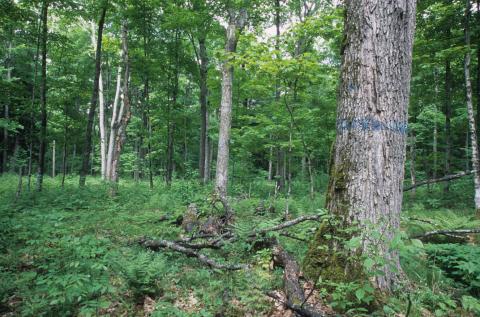I had the opportunity recently to walk through a woodland owner’s property and offer some advice. We had in-depth discussions on what she wanted to get from her woodland and how we were going to make that happen. She, like many of the woodland owners I work with, saw her woodland as one uniform forest, whereas I saw it as a mixture of many smaller, unique stands of trees making up the whole.
Her 40-acre property contained several stands unique enough to warrant their own management prescriptions. An oak stand made up most of the property, and there were smaller stands of maple/basswood, some older aspen, and an area where the trees were knocked down during the last storm and now was mostly seedlings of a variety of trees. There are a number of reasons why one woodland might have this much diversity in stand types.
One reason is that the soil types within a 40-acre property can vary dramatically. You might have richer soils where sugar maple thrives, and next to it sandier soils where oak does much better. Another reason could be the seed sources available. It is possible that an area in your woods could support a wide variety of trees, but there are only certain tree species nearby, and those are the ones spreading their seed in that area.
A third reason might be that some kind of event occurred in the woodland that caused the tree species to change. Without some kind of event taking place, a woodland will progress from fast growing trees that do best in full sunlight (birch, aspen) to slower growing trees that can tolerate some shade (maples) and stay in that stage indefinitely. But change is occurring constantly in our woodlands on both a small scale (single tree or a group of trees) to a large scale (acres). When something happens in our woods, for example a storm or a fire, the woods reset with a new crop of fast-growing sun loving trees. So in one 40-acre woods, you may have stands of fast growing trees, stands made up of older, shade-loving trees, and stands somewhere in between.
The landowner I was working with had three basic options to take regarding the different stands on her property. She could allow the stands to grow and change over time, she could take steps to maintain the stands in their current tree species mix, or she could change the stands via a timber harvest of some kind. Ultimately, she decided that she wanted to maintain the oak stand and the maple/basswood stand as they are. To do this, she would need to hold a shelterwood timber harvest for the oak stand and a selective harvest in the maple/basswood stand.
For the stand that was mostly aspen, she decided to harvest the older aspen and speed up its conversion to maples. And finally, the stand of mostly seedlings would be left to grow on its own. These prescriptions would help to achieve her overall goals of a healthy forest, made up of mature, high quality trees, that supported a diverse wildlife population.
In future articles, we will discuss the other pieces of an overall management plan.
